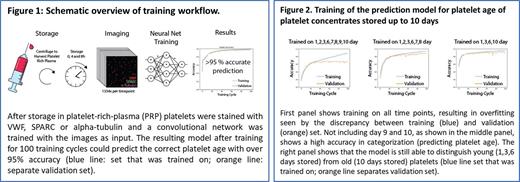Abstract
Background: Platelets are small, enucleated cells with their primary physiological role to repair vascular damage (hemostasis) and initiate thrombus formation in response to vascular injury. Low platelet count (thrombocytopenia) is associated with increased bleeding risk and is caused by decreased platelet production and/or increased platelet clearance. Platelet transfusion is a routinely used lifesaving procedure to control or prevent bleeding in patients with thrombocytopenia or platelet dysfunction. During storage platelet function deteriorates significantly over time and regulation of platelet granular content is essential in maintaining a healthy platelet function. Currently no in vitro tests are available to predict platelet age, which may be used to diagnose the underlying cause of thrombocytopenia, or to determine storage time of platelet concentrates (PC). Using confocal and super-resolution microscopy we could quantify loss of platelet granule content during aging. In this study we used Artificial intelligence techniques (AIT) to derive exact platelet age from imaging data.
Aim: To develop AIT-based algorithms that can determine platelet age from images of platelets stored in plasma-rich-plasma (PRP) and in platelets concentrates (PC) measured by confocal microscopy.
Methods: Platelets were stored in PRP for 8 hours at room temperature. Platelets were isolated and stained with antibodies for alpha-tubulin, von Willebrand Factor (VWF), SPARC or alpha-tubulin and imaged at T=0, 4 and 8 hours using confocal microscopy. Additionally 3 single donor PC in plasma were stored for 10 days at standard blood bank conditions. Platelet samples were pooled and analyzed at day 1,2,3,6,7,8,9 and 10. We trained a neural network consisting of multiple convolutional layers to classify age (time after donation) of platelets that were stored in either PRP or PC.
Results: During storage in PRP as well as of PC we used for each time point 1334 62µm x 62µm x 4µm 3D images, containing 50 to 150 platelets per image, for training. When staining with markers VWF, SPARC or alpha-tubulin alone as training set we could already classify mean platelet age up to 78%, 85%, 88% respectively. When combining all three markers a maximum accuracy of 95% for platelets stored in PRP up to 8 hours was reached (Figure 1). The additional effect of combining these three markers highlights that the model used information in the images synergistically. For PC, an accuracy of 90% was reached for classifying mean platelet age of platelets stored up to 8 days. The model could not be trained to discriminate between days 9 and 10 resulting in an overfitted model. However the model was able to distinguish day between day 1, 3, 6 and 10 (Figure 2). As negative control a model trained on a randomized sample was made. This control model was not able to assign a category correctly, indicating an actual difference in platelet characteristics during storage was detected. By using visualization of the weight-gradient (e.g. where in the images the model assigns the most weight) we additionally confirmed that the model used separate individual platelets to characterize the age of the complete platelet sample.
Conclusion: Combining confocal platelet images with a convolutional neural network, we trained a model that could synergistically integrate different stainings and information of individual platelets to predict with >95% accuracy platelet age in vitro as well as in PC up to 10 days of storage. Additionally our model could distinguish "young" platelets (stored 1, 3 or 6 days) from "old" platelets (stored 10 days).
Disclosures
Leebeek:CSL Behring: Research Funding; Shire/Takeda: Consultancy, Research Funding; Sobi: Consultancy, Research Funding; uniQure: Consultancy, Research Funding; Biomarin: Consultancy; Roche: Other: DSMB member for a study. Jansen:Argenx: Research Funding; Principia: Research Funding; CSL Behring: Research Funding; Amgen: Consultancy, Membership on an entity's Board of Directors or advisory committees; Novartis: Consultancy, Membership on an entity's Board of Directors or advisory committees.
Author notes
Asterisk with author names denotes non-ASH members.


This feature is available to Subscribers Only
Sign In or Create an Account Close Modal